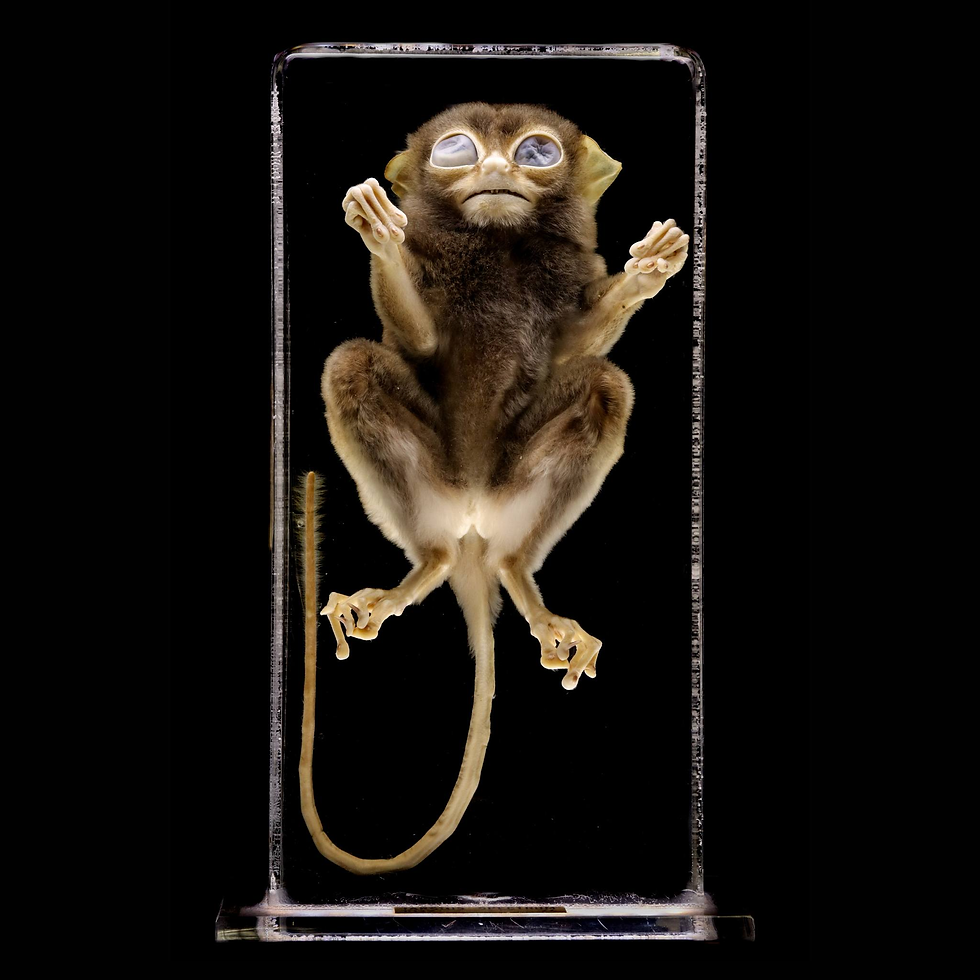Specimen Showcase | Two Big Eyes in the Dark
- Hong Kong Biodiversity Museum
- 6 days ago
- 3 min read
Imagine you are having a night walk in a forest on the Indonesian island of Sulawesi. Suddenly you notice a pair of tiny eyes staring at you, with very high-pitched squeaking calls echoing in the dark. This may generate a feeling of fear but rest assured, the creature behind the eyes and sound is just a little fluff ball — 𝘛𝘢𝘳𝘴𝘪𝘶𝘴 𝘵𝘢𝘳𝘴𝘪𝘦𝘳 (Erxleben, 1777), a primate commonly known as the spectral tarsier.

Similar to the 13 tarsier species, 𝘛. 𝘵𝘢𝘳𝘴𝘪𝘦𝘳 also possesses a pair of conspicuous and disproportionately large eyes👀. In fact, tarsiers are considered to have the biggest eyes of any mammals relative to their body weight, which are even larger, and twice as much heavier than their own brain🧠. Being nocturnal, such big eyes act as the great tools for tarsiers to navigate the surrounding. Unlike many nocturnal vertebrates, however, which have a layer of retroreflector tissue calls tapetum lucidum that reflects visible light back to the retina to enable superior night vision, tarsiers mainly rely on light-gathering capacity through their large eyes to allow the development of highly resolved pin-sharp vision even in dim light.

Due to these abnormally large eyes, tarsiers in general have the highest infant-adult weight ratio in primates as well, in which the infant of 𝘛. 𝘵𝘢𝘳𝘴𝘪𝘦𝘳 weights shockingly 20-33% of adult weight at birth, with the vast majority of the weight invested in eyes, brain mass, and cranium. For comparison, the average body weight of a human newborn is only 5% of the adult weight. At the same time, the tarsier newborn can also grow very fast in size, where they can become half as large as an adult, within 3 months after birth, to reach a head-body length of 11.7-12.7 cm📏. Considering these, the costs of carrying a newborn around would be too high for a female. Therefore, infants, for 40-50% of time, are left caching in the trees to reduce the energy efforts of adults during foraging. Of course, they are not completely being neglected during this time, instead, they would sometimes be taken care of and guarded by subadults in the family.

𝘛𝘢𝘳𝘴𝘪𝘶𝘴 𝘵𝘢𝘳𝘴𝘪𝘦𝘳 is extremely territorial, where different groups would leave scent marks to delimit their ranges, usually around their sleeping sites, by rubbing branches with urine and special scent glands in their face, stomach and genital regions. They are not afraid of engaging in disputes with neighboring groups that venture into their boundaries and would give loud duet songs to signal the neighbor to go away🗣️. The communication between tarsiers is based on different pitches and patterns of vocalization, including ultrasonic vocalizations. What makes it funny is that different species of tarsiers do not understand the unique vocalization pattern of each other, but they would continue to “sing” at each other at the same site. Just like a fierce debating, but with all the debaters speaking a different language and not understanding one another. At the same time, 𝘛. 𝘵𝘢𝘳𝘴𝘪𝘦𝘳, known for being shy and reclusive, practices predator mobbing behaviors. When predators are near, they will make a warning vocalization and the members of the group, mostly adult males, will respond to the call and show up to mob the predator, harassing it to reduce the chance of being attacked. In numbers there is strength.

Despite its small and fluffy appearance, 𝘛. 𝘵𝘢𝘳𝘴𝘪𝘦𝘳 is a ferocious predator, which is entirely carnivorous, actively preying on insects🦗, small reptiles🦎 and birds🐤. This is rather unique in primates as most are omnivorous, meaning they tend to have a balanced diet of both plants and meat, just like us! During the hunt, 𝘛. 𝘵𝘢𝘳𝘴𝘪𝘦𝘳 would locate the prey with sharp vision and echolocation, and jump on it. With their long hind limbs together with its strong muscles, Tarsiers are specialized in leaping and can jump to a distance 40 times of their body length.

Did the tarsier raise your interest in ecology and biodiversity? If so, then come to the Hong Kong Biodiversity Museum where we have many specimens, from corals to mammals, and where you can discover more about their fascinating ecology. Finally, if you found this article engaging, share it with your friends and stay tuned for more captivating biodiversity narratives released weekly!

Text: Felix Tan

Comments